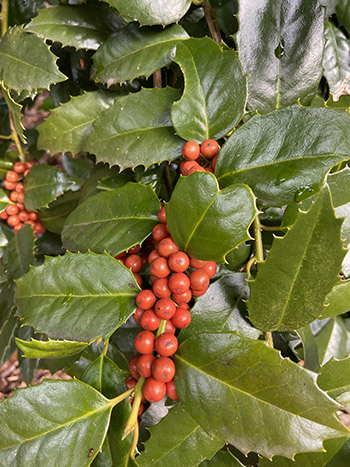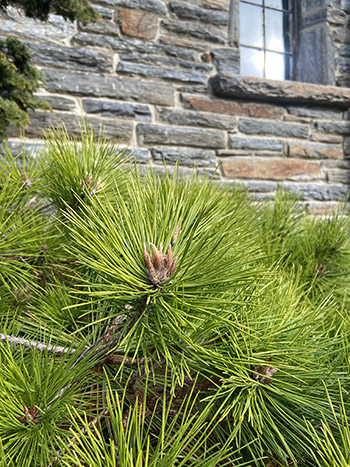
Plants of the Week: Jan. 9

Ilex ‘Mary Nell’ – hybrid holly
The holiday season is over and yet the holly and the ivy still remain. Many of our hollies in the James Frorer Holly Collection, donated by James R. Frorer in 1974, are still sporting their lustrous berries, despite the hungry winter birds. One such specimen that seems to still be rife with large clusters of berries is the Ilex ‘Mary Nell’.
This holly welcomes you into the collection on the righthand side of the main path as you head down the hillside. With exceptionally glossy, large, dark blue-green leaves, this holly also has interesting leaf margins. Smaller, but more abundant teeth give this leaf shape a more oval appearance, branching off from the traditional holly leaf shape. The berries are more orange in their appearance, a happy middle between the vibrant red we traditionally see.
This cultivar, ‘Mary Nell’, was developed by the Tom Dodd Nursery in Alabama from three Ilex species parents. Ilex cornuta which is a tough, heat tolerant Japanese holly where the ‘Mary Nell’ gets its cast-iron landscape performance from. The hybrids’ elegant and refined habit we can attribute to Ilex pernyi, which is a common breeding parent. And Ilex latifolia contributed to its striking foliage qualities. Overall this breeding has created a tough, adaptable, and attractive holly that matures up to 25 feet in height. The subtle berry color and unique leaf shape of the Ilex ‘Mary Nell’ create a distinct overall appearance that makes this holly a lovely specimen and one I certainly recommend making the trek down to the James Frorer Holly Collection to see. Photo credit: M. Rossman

Pinus densiflora ‘Low Glow’ – Japanese red pine
I am such a sucker for dwarf evergreens; they add whimsey, texture, and year-round interest to a landscape. One that is certainly providing me a lot of joy in these winter months is the Pinus densiflora ‘Low Glow’ located on the north side of the Bond-Worth Courtyard at the top of a staircase.
This cutie is native to the rocky slopes, hillsides, and lakeshores of Japan, Korea, and northeastern China. And I’m sure I have walked by this specimen many times before, but what caught my attention in the winter months was its 3-5 inch lime green needles which brighten up the gray winter landscape.
Known for its habit of growing outward rather than upward, this is a dwarf cultivar that forms a dense, compact, rounded mound. And it certainly is an excellent showcase of this cultivar because I challenge you to find a spot where a main branch is visible – it is truly a very dense mound of needles and upward facing cones.
It has dynamic curves, undulations, and an overall color that is so comforting in the winter landscape and I am so pleased to be able to enjoy the Pinus densiflora ‘Low Glow’ everyday here at the Scott Arboretum. Photo credit: M. Rossman

Hamamelis ‘Rochester’ – hybrid witchhazel
I’m starting to think that maybe the most inconspicuous flowers have some of the strongest smells. It happened multiple times with Osmanthus and just the other day it happened with the Hamamelis ‘Rochester’ near the Kyle House and Whitter Hall.
What made it difficult to associate this hybrid witchhazel with its scent was the tree’s appearance. Still clad with its brown drooping leaves, from far away it is hard to spot the open flowers of the Hamamelis ‘Rochester’. Unlike the butter yellow flowers that delight many of our witchhazels here at the Scott Arboretum, Hamamelis ‘Rochester’ has copper-orange flowers with a red base. Small ribbon-like petals look like frozen-in-place fireworks and have the most wonderful scent that is inviting and intensely fragrant. This is one of our earliest witchhazels to bloom and is just a preview of what is to come as many of our winter and early spring blooms start to gear up for their peak. Photo credit: M. Rossman





No Comments